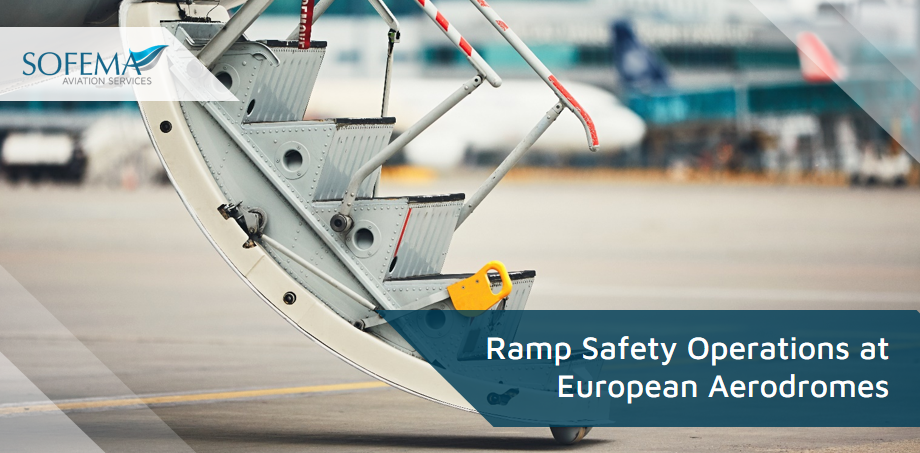Sofema Aviation Services (SAS) www.sassofia.com considers the key aspects of Aerodrome Ramp Safety Operations
Introduction
The integration of regulatory compliance, effective oversight management, and best practices in ramp safety operations is essential for ensuring the safety and efficiency of aerodrome operations in the EU. Continuous improvement, proactive risk management, and adherence to stringent safety standards are fundamental to maintaining a safe and secure environment for both aerodrome and ramp operations.
EU Regulation (EU) No 139/2014 establishes a regulatory framework and best practices aim to ensure the safety, efficiency, and compliance of aerodrome and ramp operations across the European Union (EU).
- This involves managing, certifying, and operating aerodromes while addressing the high-risk environment of ramp safety operations, including ground handling activities such as refuelling, baggage handling, and aircraft maintenance.
Key Aspects:
Oversight and Regulatory Compliance:
- EU Regulation (EU) No 139/2014: Establishes requirements for managing aerodromes, replacing national rules with standardized EU-wide safety regulations. It mandates Member States to designate competent authorities for aerodrome oversight, ensuring independence from operators.
- Standard Operating Procedures (SOPs): Developing and enforcing standardized SOPs across all aerodrome operators and service providers is crucial for uniform safety practices. Regular audits and updates to these procedures are necessary to maintain their effectiveness.
- Implementation of SMS – provides a systematic approach to managing safety, including hazard identification, risk assessment, and mitigation strategies. It is crucial for ramp safety operations and aerodrome management.
-
- Continuous Improvement: Aerodrome and ramp safety operations should incorporate continuous improvement processes, learning from incidents, and updating protocols based on evolving challenges and technological advancements.
-
- Regular Training Programs: Comprehensive and ongoing training for all aerodrome and ramp personnel is critical. This includes emergency procedures, equipment handling, and communication protocols.
- Competency Assessments: Regular assessments ensure personnel maintain the required skills to operate safely in the dynamic ramp environment.
- Stakeholder Coordination: Effective safety management requires close coordination with airlines, air traffic control (ATC), ground service providers, and emergency response teams. Regular collaborative planning aligns safety objectives across different entities.
- Technology Integration:
-
- Equipment Maintenance and Upgrades: Regular maintenance and timely upgrades of ground handling equipment are vital to reducing equipment-related incidents.
-
- Critical Issues in Ramp Safety Operations:
- Human Factors: Managing fatigue and maintaining situational awareness in the high-risk, fast-paced ramp environment is crucial. Strategies include adequate rest periods, shift rotations, and continuous monitoring.
-
- Operations often involve long hours and physically demanding tasks, leading to worker fatigue. Fatigue management strategies, including adequate rest periods and shift rotations, are crucial to maintaining alertness and reducing the likelihood of human error.
- The ramp is a dynamic environment with multiple activities occurring simultaneously. Ensuring that workers remain focused and maintain situational awareness is a significant challenge, requiring continuous training and monitoring.
-
- Incursion and Collision Risks: Implementing strict traffic management procedures and regular Foreign Object Debris (FOD) inspections are essential to prevent collisions and equipment damage on the ramp.
-
- The risk of collisions between aircraft, vehicles, and ground personnel is a constant concern. Implementing strict traffic management procedures, such as designated vehicle pathways and speed limits, is essential.
- FOD on the ramp can cause damage to aircraft and equipment. Regular FOD inspections and clean-up routines are critical preventive measures.
-
- Environmental Conditions: Adverse weather and poor lighting can impact ramp safety. Effective weather monitoring, de-icing protocols, and adequate illumination are necessary to mitigate these risks.
- Incident and Emergency Response: Preparedness through regular drills, clear communication protocols, and incident reporting are key to minimizing harm and preventing future occurrences.
- Human Factors: Managing fatigue and maintaining situational awareness in the high-risk, fast-paced ramp environment is crucial. Strategies include adequate rest periods, shift rotations, and continuous monitoring.
- Runway and Surrounding Area Safety:
- Runway Safety: Amendments to Regulation (EU) No 139/2014 ensure compliance with ICAO standards, enhancing safety related to runway incursions and surface conditions.
- Aerodrome Surroundings: Member States must manage construction and human activities near aerodromes to avoid interference with aircraft operations, ensuring safe aerodrome surroundings.
- Wildlife Hazard Management:
- Procedures for Wildlife Management: Continuous monitoring and reporting of wildlife hazards are required to prevent wildlife strikes, with information forwarded to ICAO.
- All-Weather Operations and Information Security:
- All-Weather Operations: Rules for implementing all-weather operations have been incorporated, ensuring safe operations under all conditions.
- Incident and Emergency Response:
- Preparedness and Drills: Rapid and effective response to incidents is crucial for minimizing harm. Regular emergency drills, clear communication protocols, and well-defined roles and responsibilities are key to preparedness.
- Incident Reporting and Analysis: Encouraging a culture of reporting all incidents and near-misses and conducting thorough investigations to identify root causes helps in preventing future occurrences.
Next Steps
Follow this link to our Library to find & download related documents for Free.
Sofema Aviation Services Provides Regulatory Training covering Airside Safety. For questions and comments, please email team@sassofia.com.
Tags:
Safety Management System SMS, Regulatory Compliance, Aviation safety training, SAS blogs, Hazard Management, Risk Mitigation, Aerodrome Safety, Sofema Aviation Services (SAS), Ramp Safety Operations, EU Regulation (EU), No 139/2014, Ground Handling Safety, Human Factors in Aviation, Foreign Object Debris (FOD) Management, Airside Safety Training




